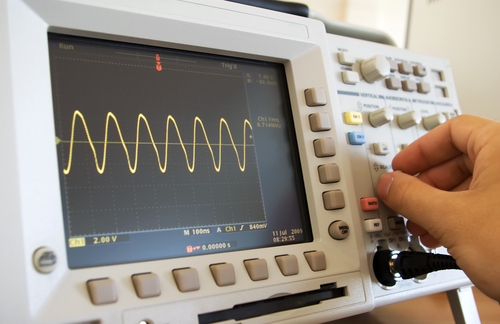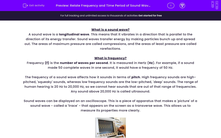What is a sound wave?
A sound wave is a longitudinal wave. This means that it vibrates in a direction that is parallel to the direction of its energy transfer. Sound waves transfer energy by making particles bunch up and spread out. The areas of maximum pressure are called compressions, and the areas of least pressure are called rarefactions.
What is frequency?
Frequency (f) is the number of waves per second. It is measured in Hertz (Hz). For example, if a sound made 50 complete waves in one second, it would have a frequency of 50 Hz.
The frequency of a sound wave affects how it sounds in terms of pitch. High frequency sounds are high-pitched, 'squeaky' sounds, whereas low frequency sounds are the low-pitched, 'deep' sounds. The range of human hearing is 20 Hz to 20,000 Hz, so we cannot hear sounds that are out of that range of frequencies. Any sound above 20,000 Hz is called ultrasound.
Sound waves can be displayed on an oscilloscope. This is a piece of apparatus that makes a 'picture' of a sound wave - called a 'trace' - that appears on the screen as a transverse wave. This allows us to measure its properties more clearly.

How does time period relate to frequency?
A final definition to learn is time period (T). This simply means the time taken for one complete wave to pass a given point. As it is a time, it is measured in seconds (s).
Waves with high frequencies have low time periods (and vice versa). They are the inverse of each other. So, the relationship between frequency and time period is very straightforward:
T = 1 ÷ f
or
f = 1 ÷ T
For example:
If a wave has a frequency of 100 Hz, its time period is:
T = 1 ÷ 100 = 0.01 seconds.
If a different wave has a time period of 0.5 seconds, its frequency is:
f = 1 ÷ 0.5 = 2 Hz.
The equation itself is easy to use. You just have to make sure you put the numbers in the right place. For instance, do not say T = f ÷ 1, as this would just divide the frequency by 1 and give the same answer for the time period!
Now let's see how you get on with the questions in this activity.








